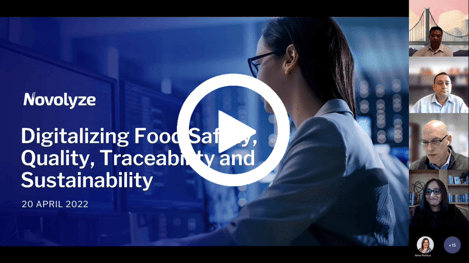Digitalizing Food Safety, Quality, Traceability and Sustainability: Factors and Challenges
In this webinar, Joe Holt, the VP for Food Safety and Quality at the OSI Group, Derrick Bautista, Director of Quality Assurance at Del Monte Foods, and Vijay Krishna the VP of Quality and Regulatory Affairs at Glanbia Performance Nutrition (GPN) discuss their journey in digitalizing Food Safety & Quality systems.
Aligning key stakeholders
The food safety experts shared with their audience critical organizational strategies used in securing leadership digital buy-in and the growing pain and benefits that come with digitalization. Discussions on traditional manual solutions in food safety and quality assurance and how they differ from digital process solutions are some of the subjects addressed during the online forum. According to Joe Holt "digitalization strategy is driven by a strong desire to prevent food safety issues. At a macro level, we want to be able to predict and intervene before bad things happen." Joe states that OSI is looking for digital strategies that provide information in a format that informs and empowers its people about what's going on in the factory network. He shares, "we want to act on it in real-time and give our workers the platform to speak about what they are seeing."
Creating stakeholder value across the value chain is a common theme expressed by all three guest panelists during the webinar event. The speakers stressed the significance of aligning key stakeholders on a common goal.
Using an external resource
One of the illuminating ideas discussed that helps drive organizational alignment and support was retaining the services of a third-party service provider. The rationale for utilizing this service is to help an organization understand how digital transformation works and the cost associated with embarking on a digital journey. Derrick Bautista, Director of Quality Assurance at Del Monte Foods, states, "9 out of 10 people will need a coach to assist them in learning how to ride a bike. Using a third-party service in assisting his organization in understanding what riding a bike should look like is a process with cost implications for his organization."
Vijay Krishna at Glanbia Performance Nutrition shared that one of the first things they had to do was develop a road map and decide where they wanted to start. He states, "one of the hardest parts is usually choosing what you are not going to do and choosing what you will do." Various aspects of the business are often in distinct stages, so the roadmap needs to reflect that reality.
Having an external resource may also help objectively look at the whole process and be systematic in identifying opportunities for building efficiencies instead of automatically digitize everything. For OSI, this resulted in having their Food Safety & Quality framework described digitally and then the collected data points are linked against that framework. The same can be done for food safety plans, preventive control documents, work instructions, or even for environmental pathogen monitoring plans.
Building a business case
Another approach is to build a business case. According to Vijay, this is sometimes the most challenging step since the business reasons for improving Food Safety & Quality via digitalization often compete with other priorities, like a line expansion or implementing another solution in a different part of the company. In building a business case, be mindful of providing a complete picture of the impact, including tangible and intangible benefits of a proposed solution. Indeed, there is an upfront cost impact, but there are also benefits in employee engagement and productivity. In Glanbia, these decisions are managed within a CapEx process looking at food safety investment and, more broadly, digital investment.
From Joe's experience, projects go best when led by an operations person or a knowledgeable food safety leader who can commit the time to manage the change. Based on the organization's budget and size, appointing director, or leadership personnel to spearhead the digital transformation initiative may be strategically necessary to accomplish the goals envisioned. Effectively scoping the project concerning how much people's time it will take is a predictor of success.
Dealing with change management
Be prepared to deal with change management. Change will most probably mean extra work to be comfortable with the digital format. It helps to have a clear message for everyone involved about what the objectives are and what the end state looks. Derek cautions that change fatigue is real and that people deal with change in different ways. It is often helpful to identify the benefits of the proposed change and link it to how it can better the professional and personal lives of those impacted.
Security was a multi-dimensional challenge. It meant having faith in the data, securing the data with change protocols, specifying who has access, and being able to retrieve the data in timely fashion. It is interesting to note that one participant believed that data stored online can be as secure as data stored on paper while having the advantage of being more useful in terms of investigating trends and generating actionable insights. As Vijay emphasized, the ongoing digital journey should be a means for you to take action and make the necessary changes to improve the business.
Interested in the digitalization of Food Safety, Quality, Traceability and Sustainability? Register for our Webinar Series.





